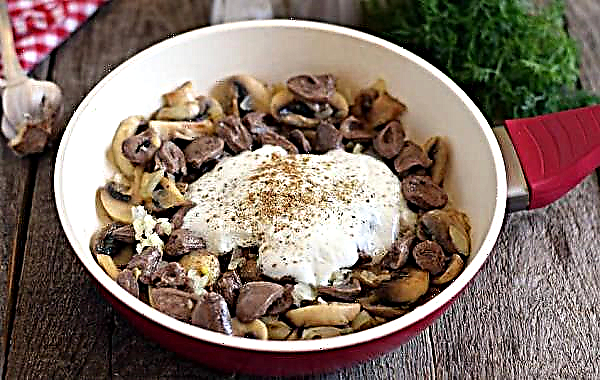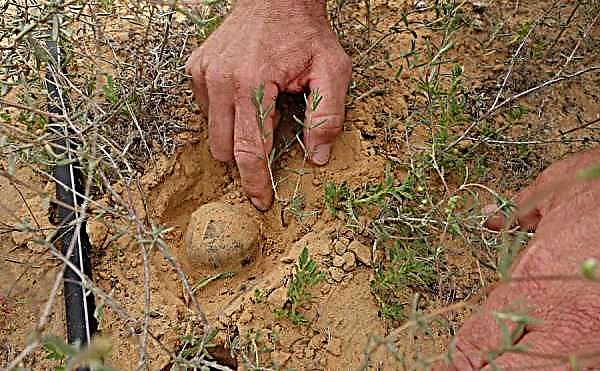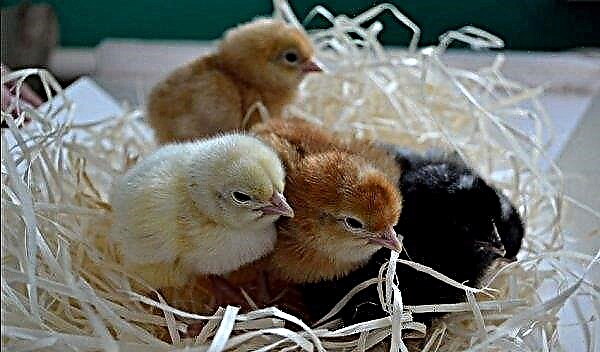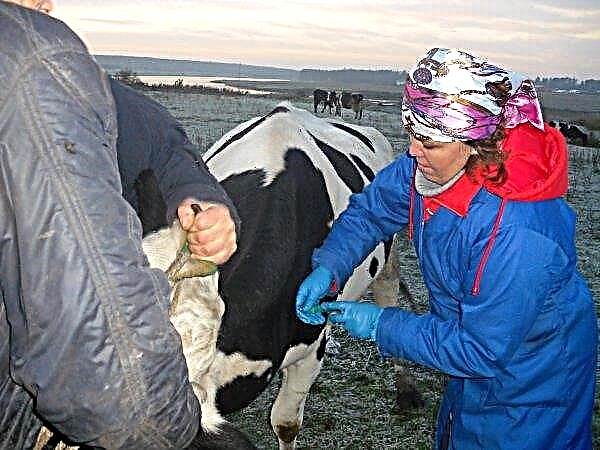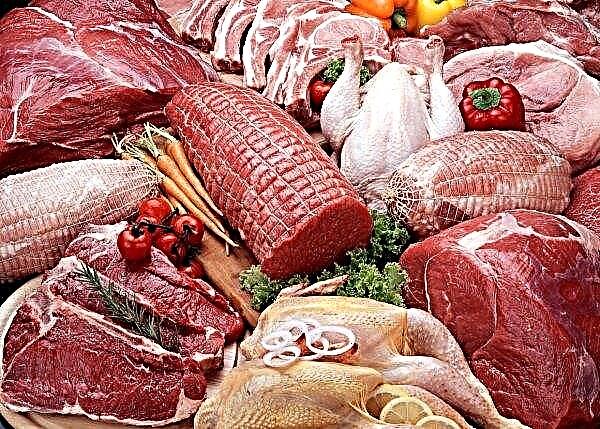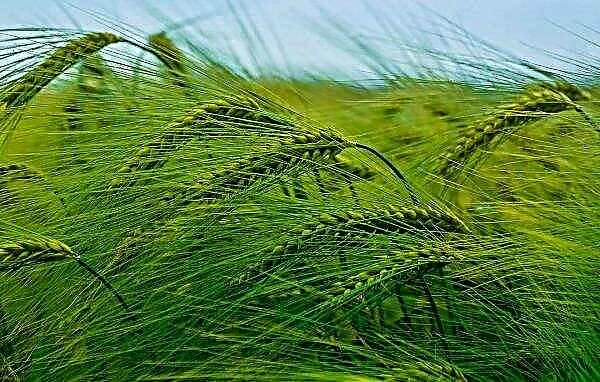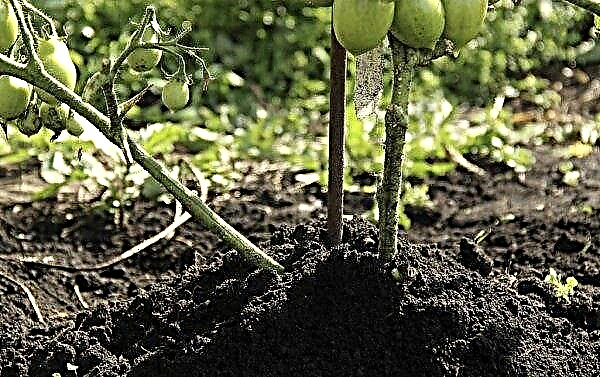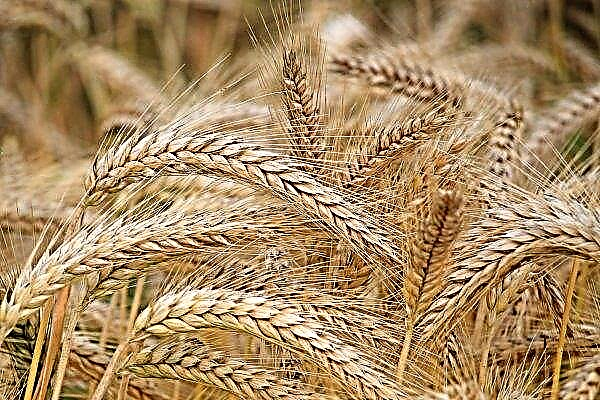Almost every garden has at least several rows of carrots. This vegetable is used to prepare various first and second courses, and it is also able to be stored all winter. In this article, we will talk about late carrots of the Queen of Autumn variety, find out its characteristics, understand how to grow it correctly and when to harvest this root crop.
Characteristics and description of the variety
Carrot Queen of Autumn - a bright orange color, long, smooth, has the shape of a cylinder with a sharp tip. The leaves are green, with a strongly dissected leaf plate. The root crop is up to 20–25 cm long, the weight of the fruit at the end of the growing season is 200–230 g. The variety has excellent yield, with proper agricultural technology, you can collect up to 9 kg of root crops per 1 m².
The variety is grown for winter consumption. In a cool, well-ventilated area, root crops can be stored almost until spring. This carrot can be eaten raw, as well as prepare juice, first and second courses, and even confectionery (cakes, pies) from it.
Origin of the variety
The queen of autumn was tested by Russian breeders in the field and entered the Rosreestr in 2005. The rightholders of the variety are the seed-growing Russian firms Intersemya, Euroseeds, and Russian Seeds.
Landing Region
Carrot Queen of Autumn is suitable for cultivation in the central regions of Russia, in the Far East, in European countries (Poland, Germany, Austria, Ukraine, Belarus).
Important! To protect carrot beds from a miner fly, crop carrots need to be interspersed with rows of onions. The plants mutually protect each other, scaring away the pests of the neighboring culture with their smell.
Productivity
On scarce soils, the yield of this variety is approximately 256 c / ha, and on well-seasoned soils with rotted organic matter, the yield is almost doubled and reaches 520 c / ha.
Ripening time
The queen of autumn is a late-ripening variety of carrots, the interval between sowing seeds in the soil and harvesting is from 120 to 130 days. For example, if the seeds are sown at the end of April, the harvest will be carried out in the first half of September.

Pros and cons of the variety
Even among the great variety variety of this vegetable, the Queen of the Autumn is very popular among gardeners. Consider the advantages of this carrot and its disadvantages.
- Grade Advantages:
- large, sweet and juicy root crops;
- the possibility of long-term storage;
- stable yield.
- The disadvantages of the variety:
- dim coloring of the root crop;
- tendency to develop rot (if stored improperly).
Features of planting varieties
The optimum temperature during the growing season is in the range +20 ... + 22 ° C. It is advisable to grow carrots in a well-lit place. In the shade, plants can also grow, but their underground part will be stiff, sinewy and have poor quality roots.
Did you know? Contained in carrots carotene is indicated in the table of food additives, allowed by the Ministry of Health a combination of letters and numbers E160a.
Choosing a place and preparing the garden
This plant grows well on loamy and light sandy soils. The earth must be permeable to moisture and oxygen, rich in humus, with a neutral pH (6.5–7.5). Dry seeds, subject to moist soil, germinate 10-12 days after sowing; if the soil is not too wet, germination can take up to 20-25 days.
After spring fertilizing, the soil is plowed or dug to a depth of 20-30 cm with a turnover of the formation so that the fertilizers are embedded in the soil.  On clogged soils before the start of sowing, the surface of the bed is treated with one of the herbicides ("Hurricane", "Tornado"), this procedure is carried out 6-7 days before sowing.
On clogged soils before the start of sowing, the surface of the bed is treated with one of the herbicides ("Hurricane", "Tornado"), this procedure is carried out 6-7 days before sowing.
If sowing carrot seeds is carried out in late autumn, then the seeds are sown after the air temperature drops below + 5 ° C. Such late planting dates are necessary so that the seeds do not have time to germinate under the influence of high temperatures. During the winter, the seeds swell, stratify, and sprout with the appearance of spring heat.
The work on preparing the land for sowing carrot seeds includes:
- cleaning the beds from the predecessor culture;
- laying fertilizer in the ground;
- loosening the soil.
Important! You can protect carrots from insect pests on small garden beds by covering the crops with agrofibre and sprinkling the edges of the cloth tightly with soil. When covering, agrofibre is laid on a bed “with an inlet”, so that nothing prevents the growth of carrots.
Crop rotation rules
Good carrot precursors are:
- peas;
- lentils
- autumn siderates;
- eggplant;
- Pumpkins
- cucumbers
- Tomatoes
- potatoes
- pepper.

Carrots can be returned to their original place of planting not earlier than after 3 years, since pests and diseases characteristic of this particular culture can persist for a long time in the soil.
In subsequent years, it is desirable to grow legumes in these areas, which can enrich the soil with nitrogen, or vegetables belonging to the solanaceous or cruciferous family. It is undesirable to grow root crops by root crops, for example, carrots after parsnips or beets.
Seed preparation and sowing
Carrots are sown by direct sowing directly into the soil in late autumn or spring, when the earth retains spring moisture. Usually this vegetable is sown simultaneously with planting potatoes, since at that time the soil has already warmed up well, but still remains moist.
In the southern regions, a good period for planting carrots is the first decade of April, in the central regions - the beginning of May, in the north of the country - the end of May. Seeding dates can be shifted annually in one direction or another, depending on weather conditions.
There are several popular ways to sow small carrot seeds:
- Dry seed - seed must be mixed with fine-grained dry sand in a ratio of 1: 1. Such mixing contributes to an ungutted sowing, and carrot rows will hardly require thinning.

- Sprouted seeds - 7-10 days before the start of sowing, the seeds should be soaked in a damp woolen cloth and put in a warm place until seedlings appear. Slightly sprouted seeds are used for sowing, but if the weather does not allow to start work, they can be put on the top shelf of the refrigerator, where they can be stored for 1 week.
 It is better to sow the sprouted seeds with the help of water so that the thin shoots do not break. For water sowing in a regular teapot with a long spout, you need to collect water to the top and add a couple of teaspoons of sprouted seeds there. Sow them, spilling water from the kettle along the planting furrow and periodically shaking the contents of the container with a tablespoon. After such seeding, seedlings appear on the 3-4th day.
It is better to sow the sprouted seeds with the help of water so that the thin shoots do not break. For water sowing in a regular teapot with a long spout, you need to collect water to the top and add a couple of teaspoons of sprouted seeds there. Sow them, spilling water from the kettle along the planting furrow and periodically shaking the contents of the container with a tablespoon. After such seeding, seedlings appear on the 3-4th day. - Landing on a paste - for this method, you need to pre-"sow" dry carrot seeds on paper tapes. To do this, cut from a newspaper (or other not very thick paper) strips of 2 cm wide and glue them together to obtain a tape of the desired length. The length of such a tape should be equal to the length of the future carrot beds.
 Next, drops of thick paste, cooked from water and flour, are applied to the paper. The distance between the drops of paste should be 4-5 cm - this is the optimal distance for growing carrots. On top of each drop of paste, 2 carrot seeds are laid out at a short distance from each other. Seed paper tapes are left unfolded until the paste is completely dry, after which they are folded into neat rolls and set aside until the start of spring sowing. In spring, it is enough to spread the ribbons along the planting furrows and sprinkle with earth.
Next, drops of thick paste, cooked from water and flour, are applied to the paper. The distance between the drops of paste should be 4-5 cm - this is the optimal distance for growing carrots. On top of each drop of paste, 2 carrot seeds are laid out at a short distance from each other. Seed paper tapes are left unfolded until the paste is completely dry, after which they are folded into neat rolls and set aside until the start of spring sowing. In spring, it is enough to spread the ribbons along the planting furrows and sprinkle with earth.
Carrots can be sown on the beds according to one of the schemes:
- in 5 rows, observing a distance of 25 cm between the rows and 50 cm - between the bands;
- in rows spaced 25-30 cm apart;
- longitudinal beds consisting of 2 rows at a distance of 15 cm between the rows and 50 cm between the strips.
Important! After sowing, for uniform germination of small seeds and to prevent contamination of the beds (field) by weeds, the soil must be compacted using a roller. On small beds in several rows, compaction can be carried out using the rake back for work.
When sowing, seeds are laid in furrows to a depth of 1–1.5 cm on heavy soils or 2-3 cm in depth on light soils. The standard for the consumption of seed material (using mechanical seeders) is 7–8 kg / ha for autumn crop sowing and 4–6 kg ha for spring sowing.
If germinated seeds are sown, the standard seed rate does not exceed 3-4 kg / ha. Sowing carrots with germinated seeds is recommended for quick entry and better crop uniformity. For manual sowing on small beds, approximately 50 g of seed per 100 m² of land is consumed.
Crop Care
After the emergence of seedlings throughout the growing season, carrot aisles must be weeded. This is done so that after rains on the soil a dense crust does not form, which prevents the access of oxygen and moisture to the roots of plants, and also to prevent the appearance of weeds on the crop.

The frequency of weeding and cultivating row spacing:
- The first weeding is carried out after the appearance of the first seedlings.
- The second weeding is carried out after the appearance of 4-5 leaves on the culture, and is combined with thinning plants in a row. When thinning leaves the plants at a distance of 4-5 cm from each other.
- All further weeding is carried out as necessary (the degree of weed spacing between rows by weeds or after heavy rains).
Watering and fertilizing
Watering during the growing season is carried out about 5-6 times. It is very important to water the carrots during root formation. When watering for each running meter of the bed, 5-7 liters of water are used. Irrigation work should be carried out 1 time in 7-10 days. Watering is carried out as necessary, if the soil has dried to a depth of 10 cm.
In rainy years, the number of crop irrigation decreases. Watering the crop should be moderate, as adult root crops with an excess of moisture in the soil are prone to cracking or the formation of rot on the roots. You can also combine watering with top dressing. For this, mineral fertilizers are dissolved in water or scattered on the surface of the beds before heavy watering.
Important! In the fall, land for growing carrots can be seasoned with well-rotted organic fertilizers such as cattle manure. Fresh manure can not be introduced, as it provokes the occurrence on carrots root rot and promotes branching of root crops.
During the growing season, under the carrots, the following mineral fertilizers are applied twice:
- after the first thinning - 60 g of potassium, 50 g of nitrogen, 40 g of phosphorus;
- during the second feeding (3 weeks after the first) use half of the previous dose - 30 g of potassium, 25 g of nitrogen, 20 g of phosphorus.
Pest and Disease Control
Common diseases on planting carrots:
- Bacteriosis, or wet rot - The disease is especially common in rainy years. Brown and wet spots appear on the vegetables, which over time, growing, can cover the entire root (including during storage). The disease is often transmitted by insects. As a prevention of bacteriosis, it is necessary to avoid the cultivation of carrots on swampy soils, observe crop rotation and use insecticides on crops.

- Sclerotinia, or white rot - moist spots appear on the roots, covered with white mold (fungal spores). Prevention - crop rotation, visual control of vegetables during storage and the rapid removal of infected root crops from storage.

- Septoria - the disease occurs on leaves, stems, petioles in the form of blackening of individual sections. To prevent the disease, the crops are treated with chemicals “Bravo 500 SC”, 0.2% (20 ml per 10–13 L of water), “Dithane M-45”, 0.2% (20 g per 10 L of water).

- Cercosporiasis - occurs on leaves and petioles in the form of small brown spots with a yellow halo. A disease can lead to leaf loss. Prevention - harvesting the remnants of the predecessor culture, maintaining crop rotation, treating plants with fungicides (“Quadris”, “Bravo”).

- Fomoz - a fungal disease that appears during storage in the form of black-brown damage to the root without any signs of mold. At the site of damage, voids form over time, the tissues mummify. Preventive measures - harvesting in dry weather, which will help to avoid soil retention on the roots.

Pests of culture:
- Carrot nematode - develops 4–8 generations a year, pests damage the root, clogging its tissues. The first symptoms of a nematode infection are wilting and drying of the leaves. Fighting - disinfection of the soil and the introduction of granules of the drug "Bazamide" into the soil, at the rate of 3-5 kg / 100 m². Prevention - crop rotation and cultivation of crops with the Aktara 25 WG or Nemathorin 10 G insecticide.

- Green leaf aphid - in a lot of populates the leaves of carrots, eating its juices. Aphids cause the vegetable to stop growing and form poor-quality root crops. As control measures, treatment with Actara 25 WG, Decis Mega 50 EW is used.

- Wireworm larvae - Microscopic worms that live in the soil damage root crops, forming passages in them. As a fight against wireworms, deep plowing and crop rotation are used, and the Syntogril Super preparation (30 kg / ha) is added to the soil before sowing.

Features of harvesting and storage of crops
Since the Queen of Autumn carrots is a late variety, and it is grown mainly for long-term storage, the harvest is carried out in the second half of September or the first decade of October. In small beds, the roots are excavated using a bayonet shovel or garden pitchfork with closed tips, after which the root crops are harvested by hand, brushing them off the ground and laying them to dry in the sun.
Did you know? In nature, wild carrots are purple or yellow in color. The usual orange carrots appeared in the XVI – XVII centuries as a result of breeding work of Dutch gardeners. It is believed that a vegetable of this color was bred in honor of the royal family of the Netherlands - the Oran dynasty.
Drying is carried out for 3-5 hours, then the root crops are sorted. Roots with mechanical damage or irregular shape are not laid for storage - they try to use them as soon as possible for food. Carrots are stored in cellars and cellars with good ventilation or in piles. Burt is a trench 70–100 cm deep, which, after laying the root crops, is covered with soil. Root crops without losses are stored in a pile until spring.

In storages, carrots are stacked in wooden or plastic boxes having side openings for ventilation. The stored carrots are sprinkled with dry sand. So, Queen Autumn carrots grow well in various regions. It not only diversifies the family menu with tasty and healthy dishes, but also has a beneficial effect on the financial situation of the gardener due to the high crop yield and long shelf life.


 It is better to sow the sprouted seeds with the help of water so that the thin shoots do not break. For water sowing in a regular teapot with a long spout, you need to collect water to the top and add a couple of teaspoons of sprouted seeds there. Sow them, spilling water from the kettle along the planting furrow and periodically shaking the contents of the container with a tablespoon. After such seeding, seedlings appear on the 3-4th day.
It is better to sow the sprouted seeds with the help of water so that the thin shoots do not break. For water sowing in a regular teapot with a long spout, you need to collect water to the top and add a couple of teaspoons of sprouted seeds there. Sow them, spilling water from the kettle along the planting furrow and periodically shaking the contents of the container with a tablespoon. After such seeding, seedlings appear on the 3-4th day. Next, drops of thick paste, cooked from water and flour, are applied to the paper. The distance between the drops of paste should be 4-5 cm - this is the optimal distance for growing carrots. On top of each drop of paste, 2 carrot seeds are laid out at a short distance from each other. Seed paper tapes are left unfolded until the paste is completely dry, after which they are folded into neat rolls and set aside until the start of spring sowing. In spring, it is enough to spread the ribbons along the planting furrows and sprinkle with earth.
Next, drops of thick paste, cooked from water and flour, are applied to the paper. The distance between the drops of paste should be 4-5 cm - this is the optimal distance for growing carrots. On top of each drop of paste, 2 carrot seeds are laid out at a short distance from each other. Seed paper tapes are left unfolded until the paste is completely dry, after which they are folded into neat rolls and set aside until the start of spring sowing. In spring, it is enough to spread the ribbons along the planting furrows and sprinkle with earth.








